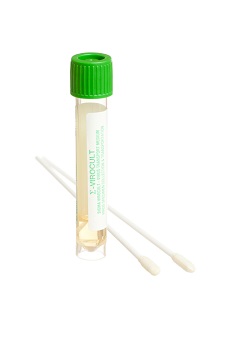Suitable Specimen Types
- Sputum
- BAL
- Trap
- NPA
- BAL
- Trap
- Nose and Throat Swab
- Throat Swab
Turnaround Time
1 dayInfluenza A- Avian Influenzas (H5 &H7) Real-time PCR
General Information
Avian influenza is an infectious disease of birds caused by the influenza A virus. Birds are the hosts for most avian influenza viruses and a variety of influenza subtypes can be found in birds, particularly in water fowl and shore birds. Domestic poultry are especially vulnerable and the virus can rapidly cause epidemics in flocks.
Human infections with avian influenza are rare. However, some viruses, such as H5N1 or H7N9, have been associated with human disease.
The symptoms of avian influenza in humans vary considerably depending on the strain or subtype of the virus involved. Most infections take the form of a flu-like illness (fever, cough, body or muscle pain, sore throat, runny nose). Other symptoms can include conjunctivitis (red, sore and discharging eyes). (UKHSA)
Avian Flu swabs are initially screened using the Biomerieux Biofire Respiratory Panel Film Array. If this does not type as a normal circulating Influenza but is Influenza A positive it is then typed further on the Roche FLOW system to investigate Avian Influenza.The influenza A(H7 and H5) tests are monoplex real-time RT-PCR assays. They are set up in parallel with our FLOW Influenza screen in order to confirm the Influenza A positive and to provide adequate internal controls. The FLOW Influenza screen includes two internal extraction controls: Escherichia coli phage MS2 (MS2) and human RNase P (RNP).
Patient Preparation
For general aspects of taking respiratory samples we recommend that users follow either their local protocols or “The Royal Marsden Manual of Clinical Nursing Procedures”.
Sputum
- Ask patient to take three deep breaths in through their nose, exhale through pursed lips and then force a deep cough. Ask patient to expectorate into a 20ml white top sterile sample container.
Bronchoalveolar Lavage (BAL)
- BAL should be collected according to local protocols using sterile fluids as the instillate. Recovered lavage fluid should be aseptically transferred to a 20ml white top sterile sample container
Nasopharyngeal Aspirate (NPA)
- NPA should be collected according to local protocols using sterile fluids as the instillate. Recovered mucus/fluid should sent in a 20ml white top sterile sample container or other well sealed sterile container.
Nasopharyngeal wash: vacuum-assisted (trap) aspirate method
- Nasopharyngeal wash should be collected according to local protocols using sterile fluids as the instillate. Recovered mucus/fluid should sent in a 20ml white top sterile sample container or other well sealed sterile container.
Nose and throat swabs for virology / molecular tests
- Use a
green topped
- virology transport medium kit (labelled as Green Top Sigma-VIROCULT swab).
- Throat: Ask patient to sit upright facing a strong light, tilt head backwards, open mouth and stick out tongue. Depress tongue with a spatula. Ask patient to say ‘Ah’. Quickly but gently roll the swab over the tonsils and posterior pharynx
- Nose: Ask patient to tilt head backwards. Insert swab inside the anterior nares with the tip directed upwards and gently rotate. Place the swab(s) in the transport liquid and snap off the swab shaft at the score line so it fits into the sample pot. Close the cap tightly and label with patient information. Label as “nose”, “throat” or “nose and throat”
Notes
Please contact the Consultant Virologist before sending any samples for H7N9 testing. Samples will not be tested without approval from the Virologist.
